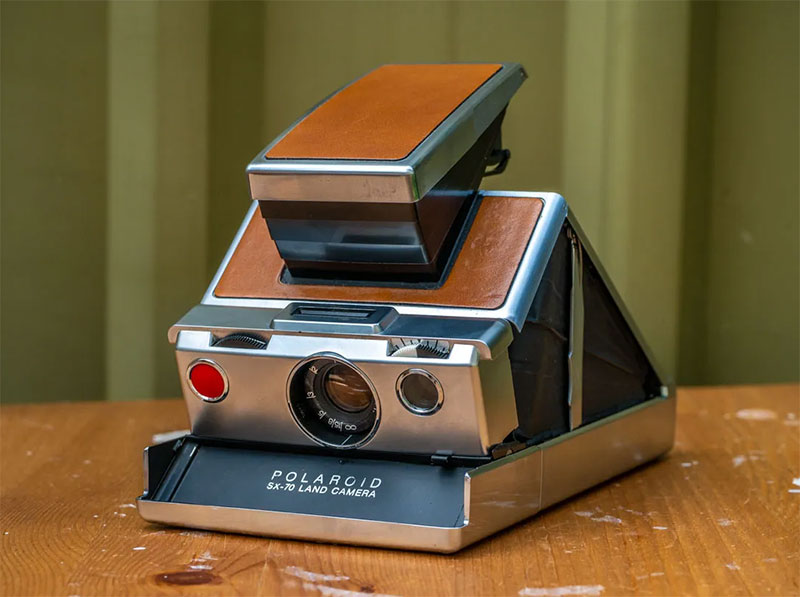Capturing the Past: What Happened to Polaroid?

What happened to Polaroid? Well, it all started with a dude named Edwin Land. Picture this: it’s the 1940s, and this guy has a wild vision – snapping a photo and getting it in your hands in minutes, not days.
That’s how the first instant camera came to be. It was like magic, right? You click the button, and bam! There’s your picture. Polaroid wasn’t just about the tech; it was about changing the game. It was the Instagram of its day, making everyone a photographer and shaping our culture in ways we’re still feeling.
Now, when you think about Polaroid’s cultural impact, you’re thinking iconic. Those square frames with the chunky white borders?
Total classics. But it wasn’t just looks.
The tech behind it was serious business. This was a time when seeing a photo meant waiting for it to develop in some dark room.
Polaroid flipped that on its head. Suddenly, you could capture a moment and hold it, right then and there. No waiting. That was a big deal, trust me.
The Golden Years of Polaroid
Innovation and Market Dominance
Fast forward to the 70s, and it’s like Polaroid’s living the dream. They’re pumping out cool stuff, like the SX-70.

This camera was a beaut – sleek, folding, looking like something out of a sci-fi flick. And it was a hit. Folks loved it. It was innovation with a capital “I”.
Now, ever heard of the razor/razor-blade business model? That’s Polaroid’s jam. They sold the cameras, sure, but the real money?
That was in the film.
You buy a camera once, but you’re buying film forever. Smart, right? They had the patents to keep it locked down tight, too. If you wanted instant photos, you had no choice – it was Polaroid or nothing.
Development of Iconic Products like the SX-70
Let’s chat more about that SX-70. It wasn’t just another camera; it was a statement. Pop it open, and it was ready to roll.
It had this cool manual focus, and the photos came out with colors that popped. People went nuts for it. It was the camera to have, period.
Early Signs of Trouble
Over-Reliance on Instant Film
But here’s the thing: when you’re riding high, sometimes you stop looking at the road ahead. Polaroid was all in on instant film.
That was their golden goose. But the world was changing. Electronics were getting smaller, smarter, better. What happened to Polaroid when tech started shifting? They kinda missed the memo.
The Missed Opportunities in Digital Technology R&D
This is where things get rocky. There’s this new kid on the block – digital photography. But Polaroid? They’re chilling, thinking instant film is untouchable.
They’re not pumping cash into digital technology R&D. Big mistake. You see, in tech, if you’re not moving forward, you’re falling behind. And fall behind they did.
Strategic Missteps
The Polavision Debacle
Alright, so let’s dive into the mess called Polavision. Picture this: it’s the late 70s, and home movies are the rage. Polaroid thinks, “Hey, let’s get in on this.”
But oh boy, they bet on the wrong horse. They drop a ton of cash on this tech that’s basically instant movies.
Cool idea, right?
But here’s the kicker: it was outdated before it even hit the shelves. VHS was already taking over living rooms everywhere. So, what happened to Polaroid here? They’re stuck with a bunch of tech nobody wants.
Investment in Outdated Technology
Polavision was like showing up to a gunfight with a slingshot. This thing could only play silent, grainy movies.
Meanwhile, VHS was offering full-length films with sound in the comfort of your living room. Not a fair fight, if you ask me.
The Aftermath and Increased Risk Aversion
So, they take this huge financial hit, right? And what happened to Polaroid after that was like watching someone who got burned by the stove.
Suddenly, they’re super cautious, too scared to touch anything that might be hot. They start playing it safe, which is like the kiss of death in the tech world.
Leadership and Vision Loss
The Departure of Edwin Land
Remember Edwin Land? The visionary guy from the start? Well, he peaces out in the 80s. And when he leaves, it’s like the soul of the company walks out the door with him.
The Shift in Company Culture and Decision-Making
Without Land, the whole vibe changes. It’s less about crazy cool ideas and more about boardroom talks and playing it safe.
They’re not taking risks, and in tech, no risk means no reward.
The Digital Revolution and Polaroid’s Response
Ignoring the Digital Camera Potential
The Rise of Digital Photography
So, the digital age is dawning. Cameras are going digital, and it’s the next big thing. Everyone sees it – well, everyone except Polaroid.
Polaroid’s Delayed and Inadequate Response
By the time Polaroid catches on, it’s like showing up to a party when everyone’s already leaving.
They try to jump on the digital bandwagon, but it’s too little, too late.
The Quest for Perfection
The Cost of Aiming for Product Perfection
In their quest to make the perfect product, they drop the ball. They’re so caught up in getting everything just right that they miss the bigger picture.
Missing the First-Mover Advantage in Digital Cameras
In tech, timing is everything. Being first out the gate can make you king. But Polaroid?
They’re stuck tying their shoelaces while everyone else is already running the race.
The Decline
Bankruptcy and the End of an Era

So, here’s the scoop on what happened to Polaroid. It’s like they’re cruising along, right? And then bam, the digital age comes in like a wrecking ball. Their whole deal with instant cameras? Yeah, not so hot anymore.
The Impact of the Digital Market on Polaroid’s Business Model
Imagine you’re rocking a flip phone in a world where everyone’s texting on smartphones.
That’s Polaroid in the digital age. Their whole film and camera gig is looking kinda old-school, and the cash flow is drying up.
The 2001 Bankruptcy Filing
Here comes the real heartbreaker. 2001 rolls around, and Polaroid’s filing for bankruptcy.
It’s like watching your favorite band break up. End of an era, folks.
Attempts at Revival
The Impossible Project and Polaroid Originals
But wait, there’s a plot twist. Some die-hard fans aren’t ready to let go. They start this thing called The Impossible Project. It’s all about bringing back that classic Polaroid vibe.
Efforts to Revive the Classic Polaroid Experience
They’re hustling to make new film for these retro cameras. It’s a bit like trying to bring vinyl back in a world of streaming, but hey, people are digging it.
The Challenges of Competing in a Changed Market
Thing is, the world’s moved on. Digital’s king, and this nostalgia trip is a tough sell. They’re like that indie band trying to make it big in a sea of pop stars.
Nostalgia Versus Innovation
The Balance Between Leveraging Legacy and Adapting to New Technology
So, what happened to Polaroid is they’re walking this tightrope, right? On one side, you’ve got their old-school cool, and on the other, the flashy new tech world. It’s a tricky act, finding that sweet spot.
The Role of Nostalgia in Modern Polaroid Products
But nostalgia’s a powerful thing. People love a throwback, and Polaroid’s milking that for all it’s worth. They’re mixing a bit of the old with a dash of the new, trying to stay relevant in this fast-paced tech party.
Lessons Learned from Polaroid’s Journey
The Importance of Adaptation and Innovation
Let’s dive deep into the whole what happened to Polaroid drama. It’s like a rollercoaster, right? Up, down, and whoa, what a ride!
The Consequences of Ignoring Market Shifts
So, picture this: Polaroid’s chilling, thinking their instant film is the bomb. But then, digital cameras roll in, and it’s like a party Polaroid wasn’t invited to. They missed the memo that you gotta evolve or get left behind.
The Need for Continuous Innovation
It’s like they had this one-hit wonder with their instant cameras, but then they hit pause. Innovation’s like streaming; you gotta keep the hits coming, or you’ll end up a one-season wonder.
The Role of Leadership in Navigating Change
The Impact of Leadership on Company Direction
When Edwin Land, the big boss, peaced out, it was like losing the captain of the ship. Leadership’s not just about calling shots; it’s about steering the ship through stormy seas and keeping an eye on the horizon.
The Importance of Visionaries in Driving Progress
Visionaries are like the GPS for companies. Without someone like Land, who had the map and the destination in mind, Polaroid kinda started driving in circles, missing turns and opportunities.
FAQ On What Happened To Polaroid
Why Did Polaroid Go Bankrupt?
So, here’s the lowdown. Polaroid, right? They were the kings of instant photography but missed the digital memo. They stuck to their instant film guns too long.
And when the digital revolution hit, they were left in the dust. Too little, too late with their digital game. So, in 2001, they had to call it – bankruptcy. It’s like they were playing checkers while everyone else moved on to 3D chess.
Did Polaroid Stop Making Cameras?
You’d think after the bankruptcy spiral, Polaroid would’ve just quit, right? But nah, they’re stubborn. They did put the brakes on for a bit. Then, some die-hard fans, who couldn’t let go, stepped in.
They started what’s called ‘The Impossible Project’, aiming to bring back those classic Polaroid vibes. So, Polaroid cameras? They’re baaack, but with a modern twist. Talk about a comeback!
What’s the Deal with Polaroid Originals?
Alright, so Polaroid Originals is like the phoenix rising from the ashes of the old Polaroid. This is the rebirth, man. After The Impossible Project crew proved there’s still love for instant snaps, they rebranded and brought back that old-school Polaroid feel.
They’re mixing nostalgia with a pinch of modern tech. It’s about keeping those classic Polaroid moments alive in a world that’s all about the now.
Can You Still Get Film for Old Polaroid Cameras?
Believe it or not, you totally can. It’s like vinyl records, there’s this retro revival happening. Companies like Polaroid Originals are churning out film for those vintage Polaroid cameras.
Sure, it might cost you more than the usual, but it’s all about keeping the legacy alive. It’s not just about snapping a pic; it’s about reliving a slice of history.
Why is Polaroid Film So Expensive?
Here’s the thing – making Polaroid film is like brewing a fine craft beer. It’s not your run-of-the-mill production. There’s a whole art to it. Plus, it’s kinda niche now, right? So, lower production volumes and the whole retro craze just pump up the price.
It’s supply and demand doing its dance, and let’s face it, nostalgia sells.
What’s the Difference Between Polaroid and Instax?
So, Polaroid and Instax are like the Coke and Pepsi of instant photography. Polaroid’s the OG, the granddaddy of instant snaps. Their pics are larger and have that classic vibe. Instax, by Fujifilm, it’s the new kid.
Smaller photos, but hey, more affordable. It’s like choosing between a vintage vinyl or streaming tunes – both rock, just in different ways.
Has Digital Photography Completely Taken Over?
Digital’s massive, no doubt. It’s like everyone’s got a camera in their pocket these days, thanks to smartphones. But here’s the kicker – instant photography’s making a comeback.
There’s something magical about holding a photo you just took. So yeah, digital’s king, but instant’s still in the game, playing its own quirky, nostalgic tune.
What Made Polaroid Cameras So Special?
Polaroid wasn’t just about taking pictures. It was a whole experience, man. You click the shutter, and bam – the photo slides out. It’s magic, unfolding right before your eyes.
It was social media before social media, sharing moments instantly. That’s the magic Polaroid bottled up – instant gratification and a tangible slice of time.
Can Polaroid Compete in Today’s Market?
It’s like David and Goliath, with Polaroid slinging its instant-camera stone against the digital Goliaths. But here’s the twist – they’ve got this nostalgia factor. It’s not about competing on the same level.
It’s about carving out their own niche, where memories are more than pixels. They’re tangible, real, and instantly in your hands.
What Does the Future Hold for Polaroid?
The future’s this crazy, unwritten story, right? For Polaroid, it’s about balancing their legendary past with the tech-savvy present. They’re not trying to outpace smartphones or DSLRs.
They’re embracing their unique instant charm, sprinkling a bit of modern tech magic on top. It’s about creating a space where nostalgia meets innovation. Who knows? In a digital world, that analog touch might just be their golden ticket.
Conclusion
Alright, let’s take a moment and rewind. Thinking back on what happened to Polaroid, it’s like watching an old film. You know, the kind with its quirks, pops, and unexpected twists.
Polaroid wasn’t just a brand; it was a whole vibe. They turned moments into memories you could literally hold. The idea was genius, right? Snap a picture and bam, it’s right there in your hands. It was more than technology; it was magic. That’s the kind of mark Polaroid left – it changed the way we captured life.
Ever play that game of ‘what if’? Like, what if Polaroid jumped on the digital train? Could’ve been a game-changer. Maybe they’d be the ones leading the photo game today. But hey, hindsight’s 20/20, right?
Now, looking forward, Polaroid’s got a chance at a second act. There’s this whole retro wave, and they’re riding it. Maybe, just maybe, they can blend that old-school charm with some fresh tech. Who knows? In a world where vintage meets modern, Polaroid could find its groove again.
If you liked this article about what happened to Polaroid, you should check out this article about what happened to THQ.
There are also similar articles discussing what happened to Compaq, what happened to Sbarro, what happened to Nortel Networks, and what happened to Sharper Image.
And let’s not forget about articles on what happened to Tower Records, what happened to Netscape, what happened to Quibi, and what happened to Digg.
- The Benefits of Integrating Geofencing with CRM Systems - May 8, 2024
- Create Your Game: The Best JavaScript Game Engines - May 8, 2024
- Dart in Development: What is Dart Used For? - May 8, 2024








